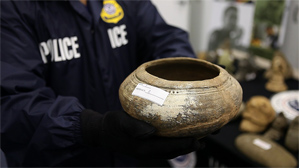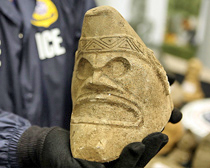Archived Content
In an effort to keep ICE.gov current, the archive contains content from a previous administration or is otherwise outdated. This information is archived and not reflective of current practice.
ICE and CBP return 67 artifacts to the Dominican Republic
Santo Domingo, Dominican Republic — On Thursday, U.S. Immigration and Customs Enforcement (ICE) and U.S. Customs and Border Protection (CBP) returned a collection of 67 artifacts illegally imported into the United States from the Dominican Republic. The objects were discovered as part of several investigations by ICE's Homeland Security Investigations (HSI) and CBP - one in Jacksonville and Orlando, Fla. and San Juan, Puerto Rico, and the other in Memphis, Tenn.
The artifacts were presented during a joint repatriation ceremony attended by Dominican Ambassador to the United States Raul H. Yzaguirre and ICE Assistant Director for International Affairs Luis Alvarez.
"We are very committed to the ability to fight against the plundering of cultural heritage and the illicit trafficking of cultural property and that, one way or another, they are [this is a way of] stealing from peoples their historic past. The artifacts that we see here today are a testimony to the rich cultural heritage of this land. Some of these pieces, as the experts have said, are two thousand years old."
In May 2008, 66 artifacts were seized pursuant to an investigation started in Jacksonville. In the first case, CBP officers in Orlando conducted an inspection of 11 boxes, manifested as "stone figurines" and destined for an individual in Jacksonville from the Dominican Republic. Further research revealed that the importer was already under investigation for allegedly importing and selling stolen cultural antiquities. CBP officers detained the shipment for further investigation by ICE HSI.
In the second case, ICE HSI agents in Jacksonville identified and seized a shipment consigned to the same individual in Jacksonville. A curator from the University of Florida later revealed that artifacts seized in Orlando and Jacksonville were determined to be from the periods of Chicoid A.D. 1200 to 1500; Archaic or later 2000 B.C. to A.D. 1200; or Ostionoid A.D. 1000 to 1500.
In the third case, a relative of the importer of the items in the first two cases was encountered and detained by CBP officers at the Luis Munoz Marin International Airport in San Juan, as he was returning from the Dominican Republic with seven additional pre-Columbian artifacts. These items were also seized by CBP and ICE HSI, and were later evaluated by the Puerto Rico Institute of Culture and determined to be historical artifacts. Of the seven items, which were made out of stone, ceramic and wood, two were determined to be from the 19th or 20th Century, three were from the 19th Century and two were from the Taino culture, A.D. 1200 to 1500. The individual, who was the subject of an INTERPOL arrest warrant from Mexico for theft of protected antiquities in that country, was arrested and turned over to the custody of the U.S. Marshals Service.
The second investigation took place in February 2011, when a CBP officer in Memphis selected a shipping container said to contain a "House Ornament Made of Stone." The package was shipped by an individual from the Dominican Republic to an individual in France. CBP inspected the artifact inside the package and held it for investigation. ICE HSI agents submitted photos of the artifact to Vanderbilt University and the University of Pennsylvania for analysis. The artifact was determined to be an owl-headed pestle, from the Taino culture, A.D. 700-1500.
ICE HSI plays a leading role in investigating crimes involving the illicit importation and distribution of cultural property. ICE HSI uses its investigative authority to seize cultural property items if they were illegally imported into the United States. It also investigates the illegal trafficking of artwork, especially works that have been reported lost or stolen. ICE's Office of International Affairs, through its 70 attache offices in 47 countries, works closely with foreign governments to conduct joint investigations, when possible.
ICE's specially trained investigators and foreign attaches partner with governments, agencies and experts to protect cultural antiquities as well as train investigators from other nations and agencies on how to find and authenticate cultural property, and how to best enforce the law to recover these items when they emerge in the marketplace.
Since 2007, ICE has repatriated more than 2,500 items to more than 21 countries including paintings from France, Germany and Austria; an 18th century manuscript from Italy; and a bookmark belonging to Hitler as well as cultural artifacts from Iraq including Babylonian, Sumerian and neo-Assyrian items.
Photos and video of the items being returned today can be viewed and downloaded at http://www.dvidshub.net/video/120163/ice-repatriates-iraqi-cultural-items.




